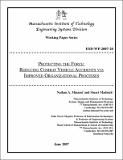| dc.description.abstract | Despite extraordinary efforts by leaders at all levels throughout the U.S. Army, dozens of soldiers are killed each year as a result of both combat and motor vehicle accidents. The objective of this study is to look beyond the events and symptoms of accidents which normally indicate human error, and instead study the upper-level organizational processes and problems that may constitute the actual root causes of accidents. Critical to this process is identifying critical variables, establishing causality between variables, and quantifying variables that lead to both resilience against accidents and propensities for accidents. After reviewing the available literature we report on our development of a System Dynamics model, which is an analytical model of the system that allows for extensive simulation. The results of these simulations suggest that high-level decisions that balance mission rate and operations tempo with troop availability, careful management of the work-rest cycle for deployed troops, and improvement of the processes for evaluating the lessons learned from accidents, will lead to a reduction in Army combat and motor vehicle accidents. | en_US |
